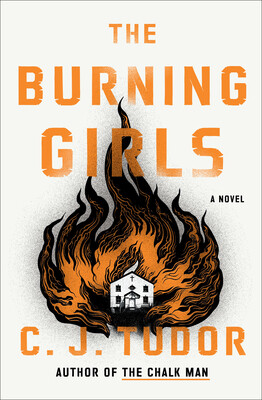Is there anything more complex than religious faith? Faith can be ineffably inspirational and intractably inflexible, a source of hope to motivate some of humanity’s greatest heroes and an excuse to defend some of our most despicable monsters. And when most people talk about the subject, they tend to focus on one quality to the exclusion of the other.
So it’s to the credit of British author C.J. Tudor that her novel The Burning Girls incorporates faith into horror story in a humane and principled manner. The book’s title refers to two young girls martyred in the 16th century for their Protestant beliefs. Today, villagers in their hometown remember “the Sussex Martyrs” as champions, holding memorial ceremonies and constructing twig dolls in homage. And sometimes, the girls’ flaming ghosts appear as omens to those who are in trouble.
The most important troubled person is Reverend Jack Brooks, a vicar who has been moved, along with her fourteen-year-old daughter Flo, to the tiny Sussex village Chapel Cross from her urban parish in Nottingham. Jack brings along her troubled past, including the murder of a young parishioner, her husband’s shadowy death, and a family history that she does not want to discuss with anyone, including us readers.
Despite her increasingly weighty baggage, Jack makes for a kind and engaging lead. Serving as the narrator for the majority of the book’s chapters (Tudor employs third-person voice for chapters focusing on other characters), Jack is quick with a quip and a forgiving aside, without ever feeling like a saint. The mercy she extends to others stems from an awareness of her shortcomings. When she begins judging a colleague for engaging in a sin of omission, she checks herself and thinks, “Who am I to judge?”
This isn’t to say that Jack doesn’t make mistakes. She gives into anger and (like all parents) constantly flubs in her decisions with Flo. But given how easily this smoking, swearing, horror-movie-watching woman of the cloth could become a “cool priest” cliché, there’s something refreshingly real to Jack’s grounded approach to the transcendent, especially to a lifelong practicing Christian like me. The Burning Girls insists that everyone has their demons and fights them their own way.
Despite the certainly admirable quality of this theme, the novel does become laden with tragedy. Everyone from a small-time reporter to a fellow vicar’s wife has a tragic backstory, which can become overwhelming. Given the mundane atrocities that mark The Burning Girls, pyro specters and crooked exorcism blades seem excessive.
The problem is exacerbated by Tudor’s sometimes too-lean prose, which prioritizes snappy dialogue over clearly defined spaces and characters. The book often reads like a script, as conversations between characters can go on for over a page, with little more than a signal phrase to break it up. As a result, the characters feel thin, as we’re forced to construct our mental image of them from the things they say, rather than the physical attributes the narrator allows us to see. This tendency crosses over from frustrating to irritating when the characters indulge in pop-culture references, talking about Evil Dead, Bill Hicks, and (with surprising frequency) The Usual Suspects. Unless you’re Nick Hornby, readers shouldn’t know more about your protagonists’ movie collections than we do about their physical features.
Fortunately, Tudor balances these issues by moving the plot along swiftly. The author shows a deft hand at revealing clues and mysteries, allowing connections between the Sussex martyrs, the disappearance of two teen girls and a local priest, and Jack’s biography, to float into view with satisfying elegance. The reader feels like an active participant in the adventure, never ahead of the characters and rarely trailing behind.
The Burning Girls treads some truly horrific ground, recounting some of the worst things humans can do to one another. And it does not shy away from the fact that religious faith often drives these acts of brutality. But it also shows us how faith can be a healing element, compelling us to care for each other, all the more in the face of such cruelty.


